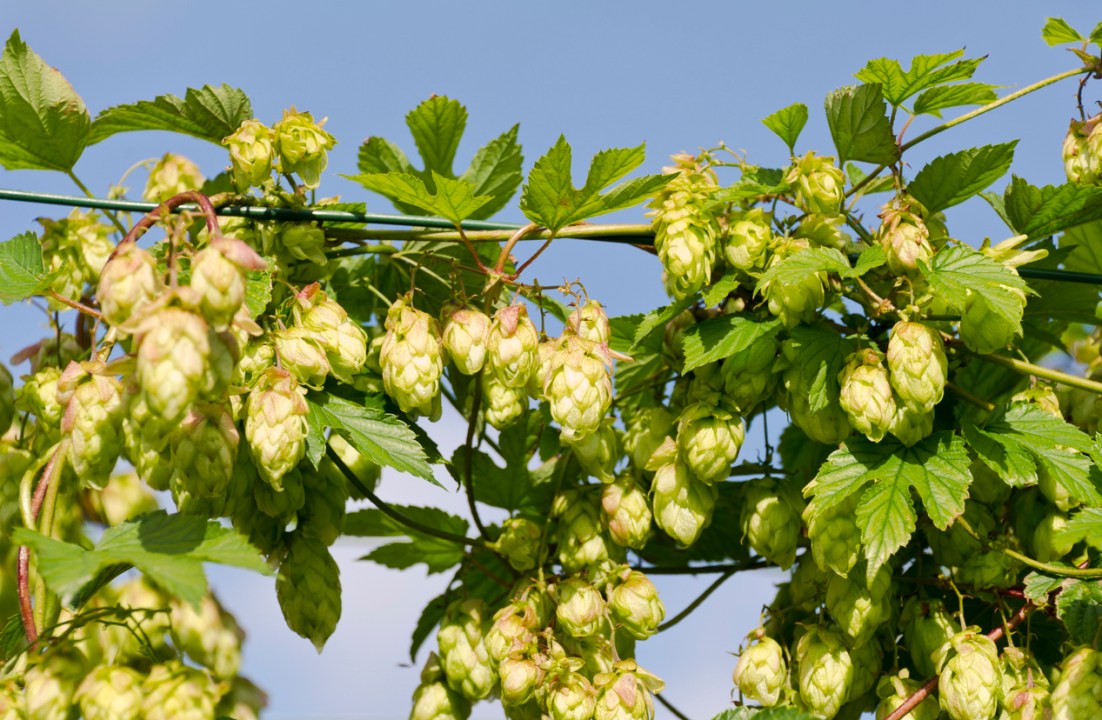There is something quintessentially English about hop fields. Rows of ten foot wooden stakes rise from the grass, perhaps three feet apart, holding up a network of wires. In the summer, hops grow up these wires like vines, forming a fragrant, uneven wall of green shades: darker leaves with soft lime-green cones. The industry has shaped Kent for centuries with terraces of former pickers’ cottages lining the lanes, and dark clay cone-shaped oast houses – remnants of a time before hops were dried industrially – dotting the landscape. Local museums preserve the testimonies of poor Londoners who escaped here from the East End in the early 20th century to spend their summers picking.
Alas, the local hop industry will soon be confined to history too. The fields are being dismantled: the wires are already gone and only a few stakes still stand. One field is already ploughed and muddy, ready for a new crop next year. That is a shame for locals: the landscape looks bare to us compared to before. But it is also part of a much broader trend.
Early signs suggest that new British varieties could be a hit abroad
The UK hop industry is in serious crisis. Production has been in decline for more than a century. Hops contain a much higher ‘bittering proportion’ these days, meaning beer-makers need fewer hops than before; nor is beer consumption what it once was. From a peak of 72,000 acres in 1872, in 2011 the UK produced only 2,500 acres, limited mostly to Kent, Worcester, and Herefordshire. But recent years have been a bloodbath. Production fell a staggering 42 per cent from 2019 to 2023. Last year, there were more hops grown by acreage in wine-loving France than the UK.
What is going on? The last few years have been tough for many farmers, first with the shock of Brexit, with its impact on farm workforces and agricultural subsidies, and then the war in Ukraine, which drove up fertiliser prices and energy costs. But hop growers point to two other issues. The first is the country’s struggling pubs. Traditional British hops – used to make bitters – work best in a cask, served through a handpull, rather than in a bottle, with carbon dioxide pushed through it. As such, the bulk of traditional British ale is sold in pubs, which were forced to shut during the pandemic. Meanwhile, beer drinkers switched to supermarket-bought bottles and cans generally made using hops from overseas.
The pandemic may be over, but pubs continue to disappear at a staggering rate: fifty pubs closed each month in England and Wales in the first half of this year. As such, demand for traditional hops has still not recovered to pre-pandemic levels. Inevitably, many farmers have had to switch to other crops.
Longer term, and predating the pandemic, there has been a shift in tastes. Around 2010, the ‘craft beer revolution’ took hold, where consumers started to shift en masse to the intense, citrus flavours made with hops generally from the US and New Zealand. As they did so, local bitters – which offer, as one grower put it to me, ‘a beautifully harmonious flavour, but not a challenging one’ – fell out of fashion. I must confess, I had my first while researching this article, a delicious Tonbridge Light Brown at my local.
But the hop industry is adapting rapidly to meet the challenge with new hop breeds. Unlike many crops, traditional hops such as the Fuggles variety have changed little in the last two or three centuries. They are low yield and – requiring enough winter frost to ultimately flower in the summer – have little resistance to climate change. Breeding programmes aim to create hops that overcome both of those shortcomings, and appeal to the new market. Will Rogers, who runs the breeding programme at hop merchant Charles Faram and Co, tells me that their aim is to ’emulate the intensity and quality of aroma and flavour’ of hops from abroad used to make craft beer. These are starting to come to market.
How will the hop industry fare in coming years? One reason for optimism about its future is climate. While traditional British hops may be vulnerable to climate change, changes to the UK’s climate are not predicted to have as large an impact on some types of farming as elsewhere. Competitors like Germany and the US Pacific Northwest are predicted to struggle with drought in future years, but changes in Britain should not impede growing hops. Of countries where crops are currently grown, this makes the UK one of those with the most secure future.
Ultimately, though, the future of British hops will come down to demand. Export markets are key. Early signs suggest that new British varieties could be a hit abroad: a beer made with British Harlequin hops won the gold medal at the US Open Beer Champion in Texas last month. But the industry needs a solid domestic market too. British brewers so far seem keen on the new varieties, as a way to produce flavours in high demand from local sources with lower carbon footprint. The question is whether British drinkers will take to them as well, supporting local hop growers in the process. To work, dear reader.








Comments